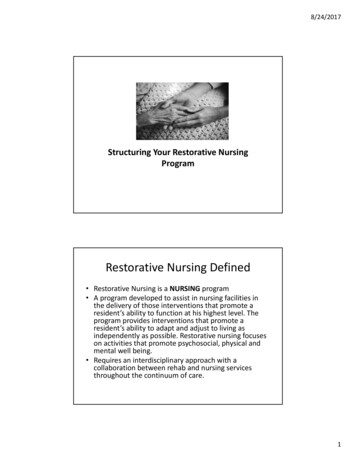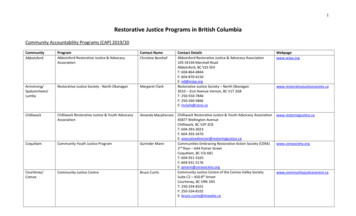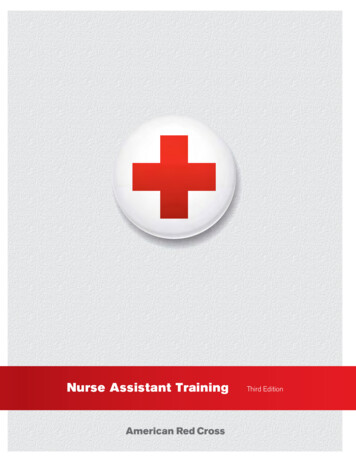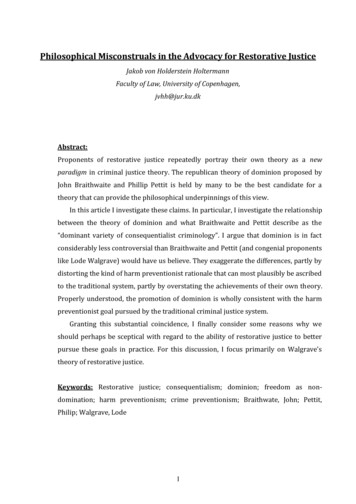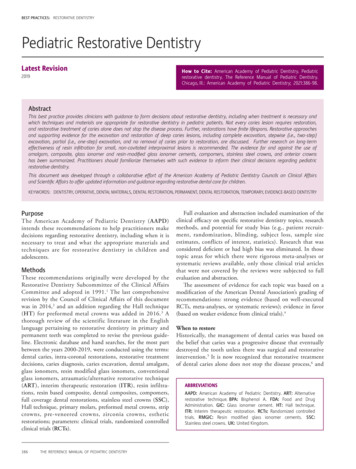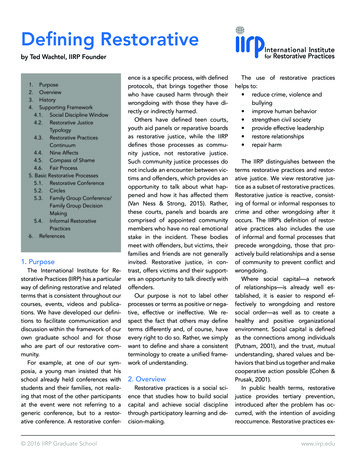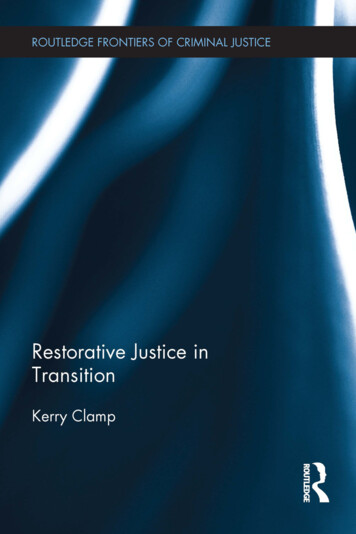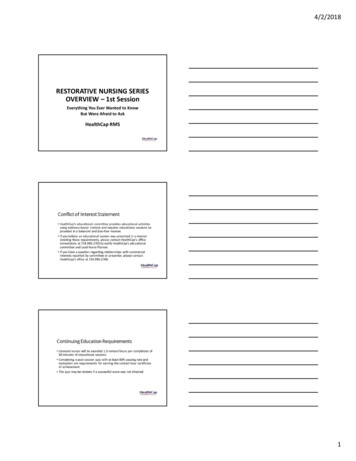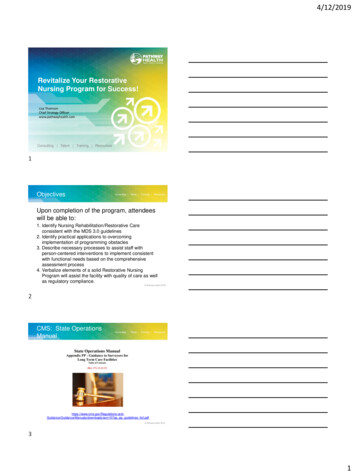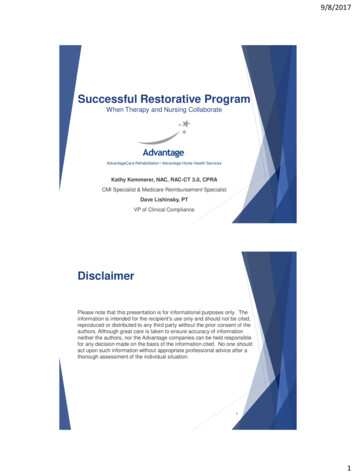
Transcription
9/8/2017Successful Restorative ProgramWhen Therapy and Nursing CollaborateAdvantageCare Rehabilitation / Advantage Home Health ServicesKathy Kemmerer, NAC, RAC-CT 3.0, CPRACMI Specialist & Medicare Reimbursement SpecialistDave Lishinsky, PTVP of Clinical ComplianceDisclaimerPlease note that this presentation is for informational purposes only. Theinformation is intended for the recipient's use only and should not be cited,reproduced or distributed to any third party without the prior consent of theauthors. Although great care is taken to ensure accuracy of informationneither the authors, nor the Advantage companies can be held responsiblefor any decision made on the basis of the information cited. No one shouldact upon such information without appropriate professional advice after athorough assessment of the individual situation.21
9/8/2017Objectives1.Learn the importance of implementing a comprehensive RNPin your SNF2.Learn how communication and collaboration between nursingand therapy will lead to a successful RNP3.Understand the impact a RNP can have on your QualityMeasures and 5 Star Rating4.Identify clinical programs that will help decreasehospitalizations and ED visits5.Learn how to audit a CMI report to identify RNP opportunities3Introduction42
9/8/2017Restorative Nursing Programs5Restorative Nursing ProgramsTechnique: Activities provided by Restorative Nursing Staff1.Range of Motion (passive): Code provision of passive movements in order tomaintain flexibility and useful motion in the joints of the body. Coding tip: Thecaregiver moves the body part around a fixed point or joint through theresident's available range of motion. The resident provides no assistance.These exercises must be individualized to the resident’s needs, planned,monitored, evaluated and documented in the resident’s medical record.2.Range of Motion (active): Code exercises performed by the resident, withcueing, supervision, or physical assist by staff. Coding tip: Any participationby the resident in the ROM activity should be coded here. These exercisesmust be individualized to the resident’s needs, planned, monitored, evaluated,and documented in the resident’s medical record. Include active ROM andactive-assisted ROM.1.3.Note: For both active and passive range of motion: movement by aresident that is incidental to dressing, bathing, etc., does not count aspart of a formal restorative nursing program. Range of motion shouldbe dellivered by staff who are trained in the proceduresSplint or brace assistance: Code provision of (1) verbal and physicalguidance and direction that teaches the resident how to apply, manipulate,and care for a brace or splint; or (2) a scheduled program of applying andremoving a splint or brace. Coding tip: Assess the resident's skin andcirculation under the device, and reposition the limb in correct alighment.These sessions are individualized to the resident’s needs, planned,monitored, evaluated, and documented in the resident’s medical record.63
9/8/2017Restorative Nursing ProgramsTraining and Skill Practice: Activities including repetition,pysical or verbal cueing, and/or task segmentation provided byany staff member under the supervision of a licensed nurse4.Bed mobility: Code activities provided to improve or maintain theresident’s self-performance in moving to and from a lying position,turning side to side and positioning himself or herself in bed. Theseactivities are individualized to the resident’s needs, planned, monitored,evaluated, and documented in the resident’s medical record.5.Transfer: Code activities provided to improve or maintain the resident’sself-performance in moving between surfaces or planes either with orwithout assistive devices. These activities are individualized to theresident’s needs, planned, monitored, evaluated, and documented inthe resident’s medical record.6.Walking: Code activities provided to improve or maintain the resident’sself-performance in walking, with or without assistive devices. Theseactivities are individualized to the resident’s needs, planned, monitored,evaluated, and documented in the resident’s medical record.7Restorative Nursing Programs7.Dressing and/or grooming: Code activities provided toimprove or maintain the resident’s self-performance indressing and undressing, bathing and washing, andperforming other personal hygiene tasks. These activities areindividualized to the resident’s needs, planned, monitored,evaluated, and documented in the resident’s medical record.8.Eating and/or swallowing: Code activities provided to improveor maintain the resident’s self-performance in feeding oneselffood and fluids, or activities used to improve or maintain theresident’s ability to ingest nutrition and hydration by mouth.These activities are individualized to the resident’s needs,planned, monitored, evaluated, and documented in theresident’s medical record.84
9/8/2017Restorative Nursing Programs9.Amputation/prosthesis care: Code activities provided toimprove or maintain the resident’s self-performance in puttingon and removing a prosthesis, caring for the prosthesis, andproviding appropriate hygiene at the site where the prosthesisattaches to the body (e.g., leg stump or eye socket). Denturesare not considered to be prostheses for coding this item.These activities are individualized to the resident’s needs,planned, monitored, evaluated, and documented in theresident’s medical record.10.Communication: Code activities provided to improve ormaintain the resident’s self-performance in functionalcommunication skills or assisting the resident in using residualcommunication skills and adaptive devices. Example:instructing, cueing and using a communication board with aresident who is hearing and/or verbally impaired. Theseactivities are individualized to the resident’s needs, planned,monitored, evaluated, and documented in the resident’s9medical record.Restorative Nursing NOTE: Restorative Nursing Programs can not be combined but canbe performed in succession: i.e. I need to do AROM before I can domy ADLs safely. NOTE: Residents with dementia learn and retain by repetition. Nursing interventions that promote the resident’s ability to adapt andadjust to living as independently and safely as is possible The nurse assistant who totally feeds Mrs. W. has noticed in the pastweek that Mrs. W. has made several attempts to pick up finger foods.She believes Mrs. W. could become more independent in eating ifshe received close supervision and cueing in a small group forrestorative care in eating. Careful observation by this CNA, has ledto a restorative program being implemented improving her quality oflife. Restorative nursing programs affect resident quality of life by allowing10the resident to be as independent as possible5
9/8/2017Restorative Nursing Restorative nursing is person-centered, whole-person nursing care. The difference in a formalized restorative nursing program is thatactivities of daily living are considered therapeutic modalities(modality is equipment used to aid that resident in performing theirrestorative nursing program). Certified nursing assistants are trained to instruct, encourage, guide,and assist residents to perform self-care skills with as muchindependence as possible. Depending on the resident, a loss ofindependence could be interpreted as a behavior issue or beingresistive to care, when in truth, that resident's independence may betheir personal values. Quality of life is a natural outcome of restorative care. Functional decline can lead to depression, withdrawal, social isolationand complications of immobility.11Rules of Restorative NursingAre Specific Restorative nursing care must be given daily At least 15 minutes, over the course of one full day, of care arerequired to qualify for one day of reimbursable care Example: a resident might receive PROM for 10 minutes on theday shift plus 10 minutes on the evening shift to equal 20minutes for the day15 minutes cannot be figured by adding time from different programs Example: 10 minutes of PROM and 5 minutes of ambulationdoes not 15 minutes in either program126
9/8/2017Rules of Restorative NursingAre Specific The care plan must include objective, measurable goals The care plan must show that a licensed nurse periodically evaluatesthe resident’s progress, and changes the care plan if needed: Referto Documentation slide Documentation can take place within a software program It is important to document the resident’s refusal of care as well astheir inability to perform programs.13Documentation Requirements Care must be taken to assure that documentation justifies thenecessity of the Restorative programs provided. Measurable objective goals and interventions must be documented inthe care plan and in the medical record. If a restorative nursingprogram is in place when a care plan is being revised, it isappropriate to reassess progress, goals, and duration/frequency aspart of the care planning process. Good clinical practice wouldindicate that the results of this reassessment should be documentedin the resident’s medical record. Evidence of periodic evaluation by the licensed nurse must bepresent in the resident’s medical record. When not contraindicated bystate practice act provisions, a progress note written by therestorative aide and countersigned by a licensed nurse is sufficient todocument the restorative nursing program once the purpose andobjectives of treatment have been established. Nursing assistants/aides must be trained in the techniques that14promote resident involvement in the activity.7
9/8/2017Documentation Requirements A registered nurse or a licensed practical (vocational) nurse mustsupervise the activities in a restorative nursing program. Sometimes,under licensed nurse supervision, other staff and volunteers will beassigned to work with specific residents. Restorative nursing does not require a physician’s order. Nursing homes may elect to have licensed rehabilitation professionalsperform repetitive exercises and other maintenance treatments or tosupervise aides performing these maintenance services. In situationswhere such services do not actually require the involvement of a qualifiedtherapist, the services may not be coded as therapy, because the specificinterventions are considered restorative nursing services. The therapist’s time actually providing the maintenance service can beincluded when counting restorative nursing minutes. Although therapistsmay participate, members of the nursing staff are still responsible foroverall coordination and supervision of restorative nursing programs. This category does not include groups with more than four residents persupervising helper or caregiver.15Restorative NursingClinical Drives The Operation Restorative Nursing is a huge part of the therapy and nursing clinicalprocess Assist in maintaining quality of life Identify declines early enough to report problems Nursing and therapy, together, can make a difference in resuming aresident’s highest functional outcome168
9/8/2017Restorative Nursing Rehab and restorative nursing are complements to one another,but not the same Rehab therapy is based on a medical model Requires fast-paced and significant progress in a short periodof timeRestorative nursing is based on a nursing model Focuses on maintaining function in a long-term, ongoingprocess Of course improvement is always hoped but not required Based on restoring or compensating for skills lost throughchronic disease, disuse or other physiological factors Usually not acute medical episode driven17Therapy’s Role The therapy team will establish the restorative programsprior to discharge from therapy Restorative programs can also be initiated by a professionalnurse when a need for these programs is recognized by thenursing staff There will be cases when CNA training on the restorativeprogram will happen while the Resident is on therapycaseload to ensure continuity of care Residents can be on a RNP in conjunction with formalizedrehabilitation therapy. Once therapy discharges and restorative nursing takesover, communication becomes key!189
9/8/2017Therapy’s Role Strong clinical programs, outcomes tracking, and frequent audits Achieve resident’s optimal physical, mental, and psychosocialfunctioning Promotes quality of life Clinical Programming starts with a LTC Advocacyphilosophy Education, training, and implementing an IDTcommunication and referral system Nursing Therapy All SNF departments19Therapy’s Role Other clinical programs that support the RNP: Splinting/contracture management Prosthesis management S&P Cognition ADLs Dining Ambulation Toileting / B & B Wound care / prevention Falls prevention Pain management Behavioral2010
9/8/2017Therapy’s Role Monthly / Qtly Audits Wounds S&P WC mobility Assistive devices Transfers Walk to Dine Toileting / incontinence ADL participation Cognition / behaviors Pain Footwear Splinting / contractures FallsProsthesismanagement Activities participation Restraint reduction Weight loss15 Star Long-stay QMs Falls w/ major injury Increased help w/ ADLs UTIs Weight loss Mod to severe pain Depressive symptoms Pressure ulcers B & B incontinenceAntianxiety or hypnoticmeds Catheters Influenza vaccine Pneumococcal vaccine Antipsychotic meds Physical restraints Ability to moveindependently worse111
9/8/2017Quality Measures23SNF QRP SNFs subject to a 2% reduction in annual payment update beginningFY 2018 if fail to meet ALL quality data submission on 80% of MDSssubmittedRequired starting Oct 1, 2016 (FY 2017) 3 QMs calculated from the MDS: Pressure Ulcers: Stage 2-4 new or worsened since a priorassessment (Admission and DC; short-stay residents) Falls with Major Injury: % of SNF patients with one or more fallswith major injury (short-stay residents) Functional Status: Self-care, mobility, cognition, andcommunication items scored (CARE tool); completed atAdmission and DC with at least one functional goal atAdmission (Section GG on MDS 10/1/16)2412
9/8/2017Hospitalizations It is estimated that 45% of hospitalizations among SNF residentsmay be prevented by targeted interventions (CMS’ “Initiative toReduce Avoidable Hospitalizations among Nursing FacilityResidents”): Hiring staff specializing in recognition and management ofconditions that cause avoidable hospitalizations Improve prescription drug management Facilitate resident transitions to and from inpatient hospitals25MDS Changes 10/1/17 Section N New item/questions on opioid and antipsychotic use RNP, Pain management, Behavior management, DementiaprogrammingSection P Restraints and alarms RNP, Activities, Restraint reduction, pain management,behavior management, falls prevention, etc.2613
9/8/2017Functional Outcomes Data, data, data . C.A.R.E. item sets Self-care Mobility Collaboration with nursing to complete Section GG Clinical programs drive outcomes to ensure residents’ reachhighest level of functioning AND/OR to maintain or prevent /slow deterioration27JimmoSpecifically, skilled therapy services are necessary for theperformance of a safe and effective maintenance program onlywhen: the particular patient’s special medical complications require theskills of a qualified therapist to perform a therapy service thatwould otherwise be considered non-skilled or the needed therapy procedures are of such complexity that theskills of a qualified therapist are required to perform theprocedure.2814
9/8/2017Rehab and Restorative CMS Form 20080 Rehab and Restorative Critical Element PathwayStaff Nurse Aide and/or Restorative Aide: Are you familiar with the resident’s care? When did restorative start working with the resident? What is restorative doing to address the [ask about specific concern]? How often do you meet with the resident? How much assistance does the resident need with [ask about specificconcern]? How do you promote the resident's participation in therapy?29Rehab and Restorative3015
9/8/2017Best Practices IDT Communication / Collaboration Quarterly Screens / Rounds Nursing Therapy Referral System Comprehensive therapy evaluation including standardized tests& measures Quarterly in-services – All Shifts Resident / family / nursing E &T (carryover) Flexible therapy schedules / Extended hours Person-centered care / Preferences Home Exercise Programs Wellness Programs Functional Outcomes & Clinical Program Audits31Best PracticesResident Preferences, Values and Culture Questionnaire1.Do you like to listen to music?2.Do you prefer to spend one-on-one time with someone?3.Do you like to read books, newspapers, and/or magazines?4.Would you like to be involved in cultural activities?5.Do you like to exercise?6.Do you have any hobbies?1.1.1.Special events, live musicBowling, golf, dance, Wii, Tai Chi, etc.Crafts, gardening, knit/crochet, painting3216
9/8/2017Best ve NursingProgram33Restorative Impact onReimbursement Daily / continuous IDT communication is the key to ensureaccurate and thorough MDS completion depicting a “true”individualized person-centered Plan of Care Each member of the IDT needs to have a good workingknowledge of each resident’s needs, level of care, and functionallevel Documentation, Documentation, Documentation CMI is best managed by all IDT members familiar andknowledgeable with the process for CMI to be managed as a“true” partnership: Nursing RNAC / MDS Coordinator Therapy3417
9/8/2017CMI and Restorative Nursing Restorative is an important part of CMI along with ADL Late LossADLs, which restorative covers 3 (bed mobility, transfer, and eating). For CMI purposes, RNP impacts reduced physical function, behaviorand impaired cognition. This makes complete sense since keepingall three RUG groupers as independent will maintain their physicalfunction, improve behavior and improve cognition with activity. Every resident benefits from restorative programs though but do notimpact the CMI but impacts their life.35CMI and Restorative Nursing In those three RUG groupers the CMI increase is slight;however, would it surprise you to know that a successfulrestorative program giving a resident 2 or more programs(keeping in mind that AROM/PROM can only be counted as 1)can improve a CMI by 0.01 (in a 100 bed facility). Remember: “Continuous Motion is Key”3618
9/8/2017CMI and Restorative Nursing Physical functioning RUGS Behavior Problem RUGS Impaired Cognition RUGS These are the three categories that Restorative Nursing isinvolved the CMI They are divided again by their ADL score This should be no surprise because a successful restorativeprogram will improve physical function, decrease behaviorissues, and repetition improves cognition.37CMI and Restorative NursingUse the following chart forbed mobility, transfer andtoilet useSelf-performanceColumn 1-, 0, 1, 7,or 82343 or 4andandandandandSupportColumn 2(any number)(any number)-, 0, 1, or 2-, 0, 1, or 23ADL Score 01234Self-performanceColumn 1-, 0, 1, 7,or 8-, 0, 1, 7,or 83 or 434andandandandandSupportColumn 2-, 0, 1, or 82 or 3-, 0, or 12 or 32 or 3ADL Score 02234example:Bed mobilityTransferToilet UseEating2/23/23/30/1G0110A G0110B G0110I Use the following chart foreatingG0110H Total0 1 2 4 073819
9/8/2017CMI and Restorative Nursing My little SNF: For CMI, you must have 2 different restorative nursing programs(AROM and PROM count as 1), for at least 15 minutes, 6 out of 7 daysin the 7 day look back 710.680.530.590.71CMI 0.63CMI 0.6639Communication Days, weeks or even months may go by with no change in theresident’s participation in the restorative program and then adecline is noticed: It is very important to report this decline to your nursing supervisor It is very important to continue to report the decline It is very important for the nursing professionals to report thedecline to therapy for evaluationThe importance of catching a potential problem early can not bestressed enough. Early detection means a better chance of returning the resident tohis/her previous baseline4020
9/8/2017Something to Think About Remember: Successful restorative nursing programs provideresidents with activities that can slow or stop a declinein function The restorative nursing “team”, all of us, can improvequality of life for residents You can make a the difference in your residents’lives. There is no better gift to give or receive thanthat!41The Vital Link:Restorative Nursing and Therapy Combine for Better OutcomesReference: Journal of Gerontological Nursing Volume 35, Issue 1:37-44A person is admitted to a nursing home from the hospital after a fall in their home. They arriveweak and probably scared about the thought of trying to walk again. They are evaluated byPhysical Therapy and treated daily to regain strength and confidence in walking but they are still notready to walk alone. After six weeks of treatment, Physical Therapy states the resident has met thegoals set for him/her at the beginning of treatment so they are discontinuing treatment. What is thenext step? Most likely, it is Restorative Nursing Programs for ambulation and exercise set up bythe physical therapist. Restorative nursing is the link between nursing and therapy that is aimed atmaintaining the gains the resident achieved while receiving skilled therapy. Some facilities chooseto implement a program using restorative nurse aides trained by therapists. Some other facilitieschoose to implement an informal program with nursing staff on the units performing the scheduledtasks daily. Either way, it is clear that restorative nursing makes a big difference in residentoutcomes and in maintaining a resident’s level of independence. Whether the restorative nursingprogram is formal or informal, communication between nursing and therapy is key to success.Restorative nursing programs and the nurse aides who provide this key daily by following the stepby step interventions of the care plans and evaluating the effectiveness of them. Documentationmust be accurate and timely. Particular attention should be paid to residents who refuse toparticipate or are unable to participate in programs. This information must be communicatedimmediately to the unit charge nurse who will then decide the proper course of action, which insome situations, may result in a referral to therapy for another evaluation. Good communicationmeans we are addressing the residents’ needs first and foremost. Providing restorative nursingprograms well requires a staff commitment to the idea of scheduling time to follow the therapists’recommendations. On the therapy side, it is important that the therapist write a restorative programthat is realistic, understandable, and accepted by the nursing staff who will deliver it. It is alsoappropriate, and often times necessary, for therapy to in-service nursing prior to the initiation ofrestorative programs to insure continuity of care Studies of facilities have revealed that a dedicatedrestorative program did foster improvement in some areas of residents’ functional abilities. Theprogram led to more consistent care delivery and a higher quality of care. It is, therefore, a42definite positive aspect of nursing care for long term care residents and should be provided for aslong as it is beneficial to them21
9/8/2017Goals Strong therapy clinical programming Strong RNP Solid IDT communication system Better care Improved QOL Successful 5 Star QM rating CMI Functional Outcomes43Summary4422
9/8/2017Questions?Kathy Kemmererkkemmerer@feeltheadvantage.comDave Lishinskydlishinsky@feeltheadvantage.comThank you!23
9/8/2017 6 Restorative Nursing Restorative nursing is person-centered, whole-person nursing care. The difference in a formalized restorative nursing program is that activities of daily living are considered therapeutic modalities (modality is equipment used to aid that resident in performing their

